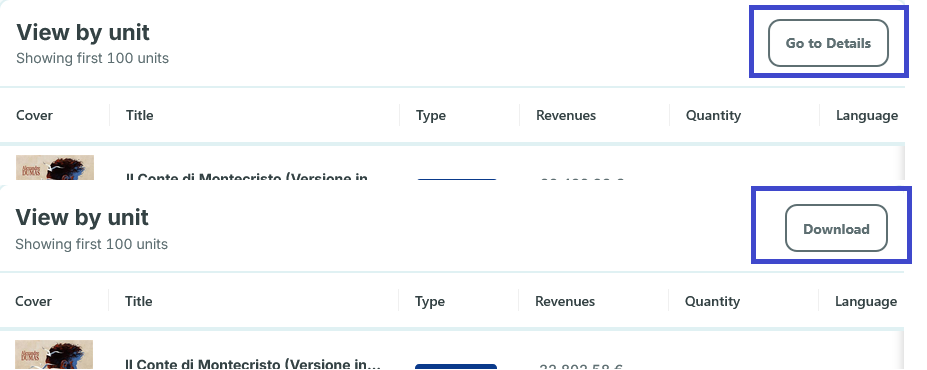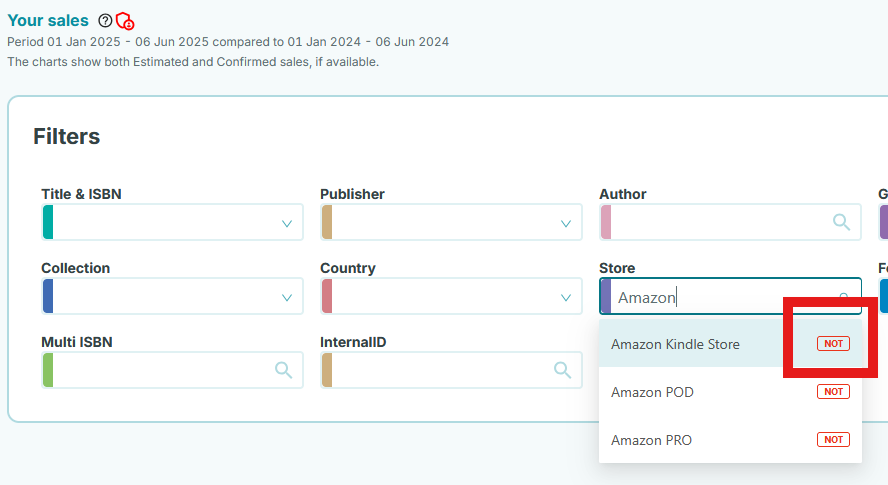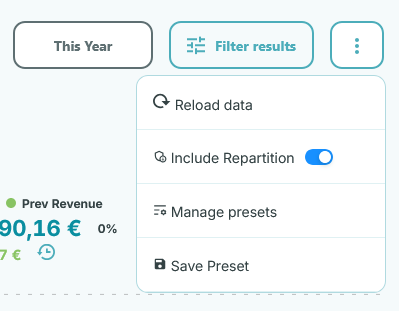Track Your Sales
Introduction
Our Analytics tool allows you to monitor the daily performance of your book sales and downloads through a clear and comprehensive interface, consisting of graphs and tables with the main groupings (business model, format, store, etc.).
The available data is updated daily and monthly, covers all three sales formats (ebook, audiobook, and paperback) and reflects information provided by the main stores in our network. Click here to find out which stores provide daily sales reports .
The data view can be customized to your needs by applying various filters: date, title, ISBN, author, library and more.
Trend Chart, Estimated and Confirmed Sales
Once you log in to Analytics, you'll find the main graph that illustrates your sales trend over the last thirty days, grouping together confirmed and estimated sales data.
- Estimated sales data : These refer to sales provided by stores on a daily basis but are not yet confirmed and are therefore subject to change. Confirmation occurs in the month following the sale. Only then are sales invoiced.
- Confirmed sales data : These are sales invoiced to stores and are not subject to change.
Depending on the time period you selected, you may notice a red line in the graph that distinguishes between estimated sales and confirmed sales.

- Revenue / Past Revenue : Analytics compares current data with previous data (by period or year). Light green represents past sales, dark green represents current sales.
Graphs, Tables, Rankings
Scrolling down the page, you'll find various types of graphs and tables that illustrate data according to different grouping criteria. Here's what some terms mean:
- Format : product type (eBook, audiobook, paperback)
- Business Model :
- À la carte sales: transaction with download
- Subscription: reading by subscription (e.g. Scribd, Kobo Plus, etc.)
- Libraries: library lending
- Refunds: Transactions linked to refunds
- Free Downloads: Stock Tracking Software Distributed for Free
- Rankings : List of the best-performing titles or stores
- Store Partner Rankings and Special Programs : includes stores such as Libri, Libreka, Amazon, Kobo (which aggregates IBS, Feltrinelli, Libraccio)
- View by Unit/Transactions : Distinguish sales by title or by single transaction
For each view, you can access the details and download the data in CSV format by clicking on “Go to details” > “Download”.
 Each box or graph shows the comparison with the previous period, highlighting the trend in percentage.
Each box or graph shows the comparison with the previous period, highlighting the trend in percentage.
The filters
Analytics offers several filters to organize your data. The Date Filter is preset to the last 30 days, but you can apply others such as Title, Author, Business Model, etc.
Please note: The date filter allows for a maximum range of 12 months.
New! You can now also exclude specific values from filters using the “NOT” condition.
For example, you can exclude a country from the “country” filter to analyze revenue excluding that market.
To do this, click on the “NOT” label next to the desired filter.
 You will get a result like this:
You will get a result like this:

To access all filters, click on “Filter results” in the top right menu.

Filter combinations can be saved and reused at any time. To save a filter, click the three dots next to the active filter. To reuse it, go to "Manage Presets."

Sales and Consumption
Analytics organizes data into two types of reports:
- Sales : Main view to monitor catalog sales (excluding streaming).
- Consumption : available only for Dreame and Storytel, shows hours of reading/listening recorded by the platforms by the minute.
How often is the data updated?
- Estimated data is updated daily.
- Confirmed data is typically available at the end of the month following the month of sale.
Example: November data will initially be estimated. At the end of December, we'll receive final data from partners, which will appear in the chart as confirmed November sales.
Notes
- Some stores (e.g., Google Play and Kobo) do not send data about free downloads.
- There is a fixed fee for free titles:find out more here .
- Ourpayment processes are based solely on confirmed data. Helpful insight:Why doesn't the amount in Analytics match the amount on the receipt?
Which stores provide estimated sales data?
You can check this in the Data & Stores section of Analytics .
